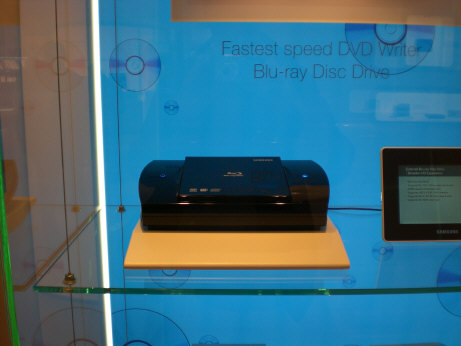
CeBIT 2007 - Notes from the Messe
After just considering to go for many years, this time I took the leap and spent 4 days at CeBIT in Hannover, Germany. Obviously, some time was spent looking into stuff that is more relevant to my daily work and I won't report on that.
Amongst all the HD format PR, I tried to find how both formats were shown on the floor and how they did on the floor as compared to the PR departments.
Blu-ray
The first Blu-ray player I spotted was at the Sharp booth. It wasn't connected to Sharp's 108" LCD screen (the biggest screen on display at the whole exhibition) - in fact I didn't see any Blu-ray content playing in the two devices they had on display.
Panasonic had just one player on display - and not hooked up to their 103" Plasma (the largest plasma at the exhibition), rather just hooked up to a normal sized Plasma and showing some Blu-ray trailers.
Samsung had more than one model on display: they had their regular standalone, as well as a semi-portable Blu-ray player and DVD recorder, and their regular Blu-ray disc recorder for PCs. Below you can see the portable device that reads BD-R at 4x, BD-RE at 2x and offers both a USB2 and a Firewire connector.

There were more Blu-ray devices to be found at the Optiarc booth - Optiarc is the Sony - NEC joint venture in the optical disc department. What I found rather peculiar was that even though NEC supports HD DVD, there was not a single HD DVD drive to be seen at the booth. I asked and was told that they wanted to do "something different" this year after showing HD DVD the last time. Of course, the lack of HD DVD equipment could also be construed as Sony being in charge.. Either way, here are a few snaps of the Blu-ray devices:
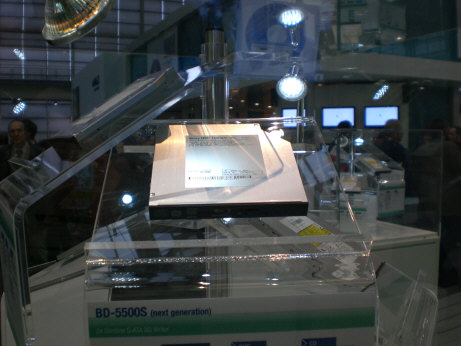 This
is the tray model BD-5500S - they also had a slot-in model (BD-5600S), both
offering the same read and write speeds: 2x burning on all BD discs, 2x reading
from BD discs, 8x DVD±R burning (both single and dual layer), 4x DVD±RW
burning, and 16x/10x DVD burning - so basically your usual notebook DVD burner
plus Blu-ray recording and reading. Both devices are only available with a SATA
interface.
This
is the tray model BD-5500S - they also had a slot-in model (BD-5600S), both
offering the same read and write speeds: 2x burning on all BD discs, 2x reading
from BD discs, 8x DVD±R burning (both single and dual layer), 4x DVD±RW
burning, and 16x/10x DVD burning - so basically your usual notebook DVD burner
plus Blu-ray recording and reading. Both devices are only available with a SATA
interface.
They also had a few BD blanks from Sony, TDK, Verbatim and Fuji on display, and Sony's BD player monster showing off some Blu-ray clips.
There was just one Blu-ray burner for regular PCs - the BD-M100A. No specs were given for this particular player.
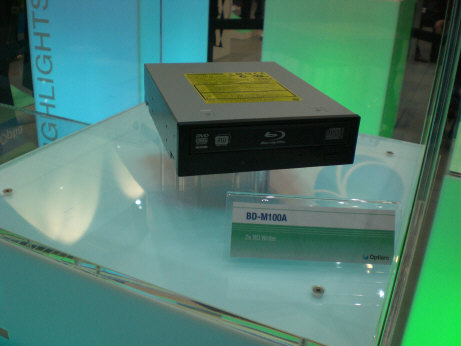
And that was it for the Blu-ray camp. Oh wait, there were a handful of storage solution makers who have upgraded their solutions to also support Blu-ray besides traditional DVDs.
HD DVD
Toshiba was the main HD DVD proponent at CeBIT. Besides them, only player makers showcased HD DVD. In fact, Toshiba had 2 booths: their regular booth, and a special HD DVD booth:
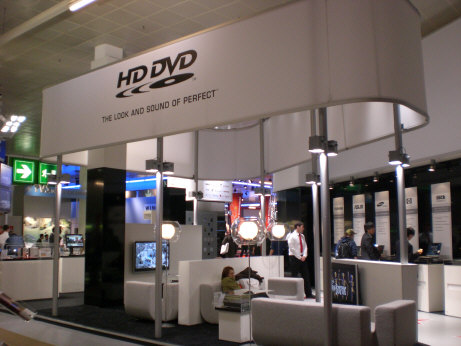 This
booth featured two living room areas where people could watch HD DVD movies,
a display of notebooks that include HD DVD drives, a collection of available
and soon to be released non PC based HD DVD hardware, and HD DVD software (authoring
and playback solutions).
This
booth featured two living room areas where people could watch HD DVD movies,
a display of notebooks that include HD DVD drives, a collection of available
and soon to be released non PC based HD DVD hardware, and HD DVD software (authoring
and playback solutions).
At the HD DVD booth, Toshiba put up all their existing PC based solutions as well - I didn't know they made the PC models in white, too:
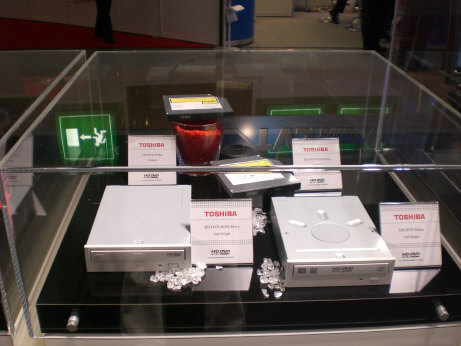
Buffalo apparently also makes an HD DVD ROM drive - the HDV-ROM2.4FB. The drive kinda looks like Toshiba's first DVD-ROM drives, don't you think?
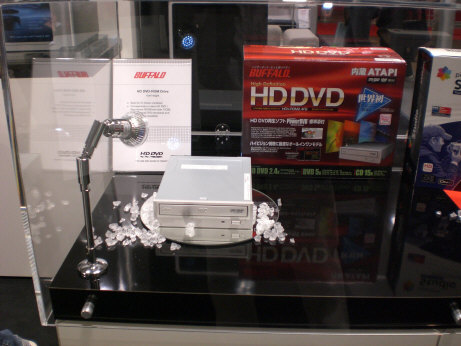
And there I thought HP was a Blu-ray shop:
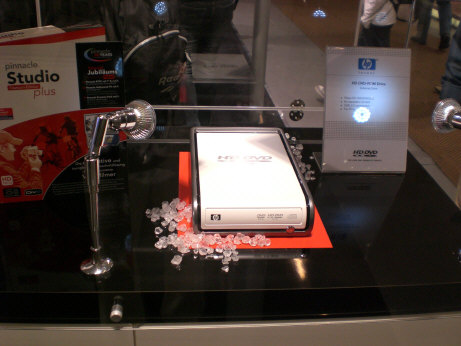 Apparently
HP also makes an external HD DVD drive.
Apparently
HP also makes an external HD DVD drive.
Toshiba was showing off a list of all companies that have something to do with HD DVD (note that the list spans all 4 sides, and below were 4 PCs showing off various PC solutions to author and play HD DVDs).
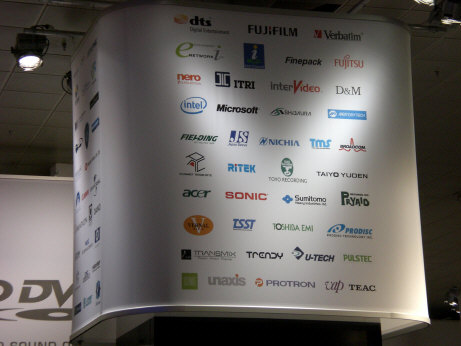
HD DVD is also making it into your car, with Alpine being the first hardware maker to come up with a HD DVD solution for your car:

Toshiba also had a third party standalone player on display - availability and price are yet to be determined but this will be HD DVD's low price model. Considering Toshiba's latest price offensive ($399 for the A2), this model might end up somewhere in the $200 to $300 range.
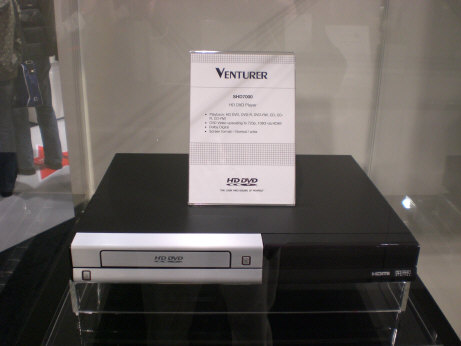
Finally, Toshiba was also hinting at external recording solutions that should be launched during the summer:
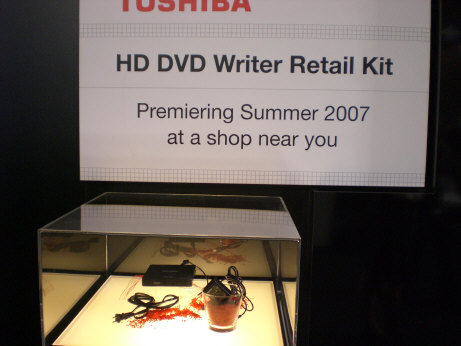
And here's a shot of all the HD DVD enabled Notebooks:
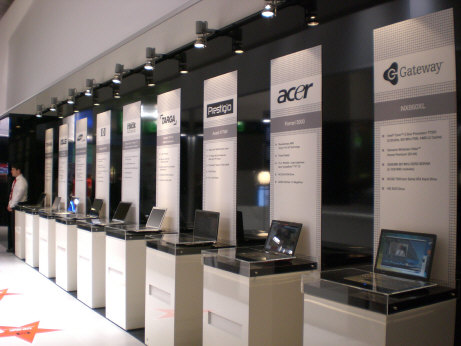 It's
rather hard to read but the list is as follows:
It's
rather hard to read but the list is as follows:
Toshiba
Asus
Samsung
HP
rock
Targa
Prestigio
acer
Gateway
As part of their regular booth was a small movie theater where HD DVD movies
were shown on a large screen and people would get popcorn to go with the movie.
The regular booth also featured Toshiba's standalone player models fully hooked
up and showing actual movies, and all of Toshiba's PC based HD DVD drives:
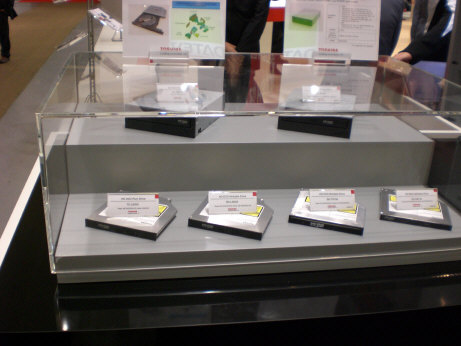 In
the lower row, we had the TS-L802A, Toshiba's HD DVD ROM drives for notebooks,
and 3 HD DVD burners: the SD-L902A, the SD-T913A and yet another one whose model
number I didn't get (mental note: take your PC with you to check out the pictures
so you can take new ones the next day).
In
the lower row, we had the TS-L802A, Toshiba's HD DVD ROM drives for notebooks,
and 3 HD DVD burners: the SD-L902A, the SD-T913A and yet another one whose model
number I didn't get (mental note: take your PC with you to check out the pictures
so you can take new ones the next day).
In the top row we have Toshiba's well-known and hardly available DVD-ROM and the upcoming SATA based HD DVD recorder (you might recall it being announced at CES earlier this year).
HD blank media
Considering the number of manufacturers that had blank DVD media on display, the number of HD DVD and Blu-ray blanks was still small - but if all those discs shown at CeBIT hit the marketplace soon, we might just see prices erode. Here is a collection of blank HD media I found on display:
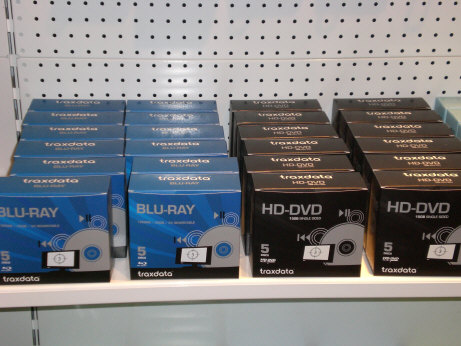
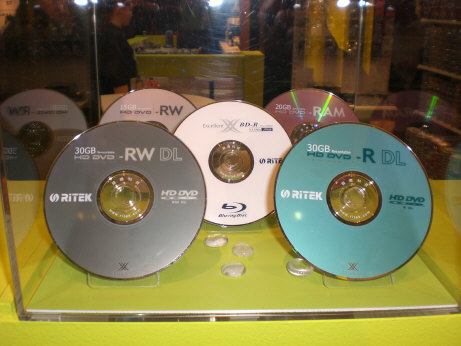
Did you know there was something like HD DVD RAM? I didn't. Traxdata didn't have any dual layer media by the way.
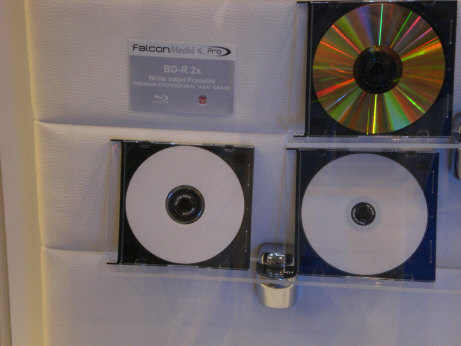
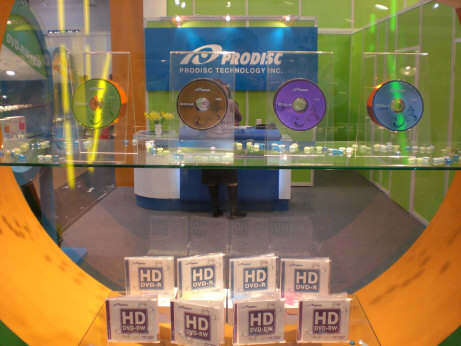
I must have forgotten to snap Falcon's HD DVD blanks - I'm quite sure the only manufacturer to only have Blu-ray on display was Nashua. When asked, I was told that they see Blu-ray having an edge and thus they will only make HD DVD if the marketplace requires it.
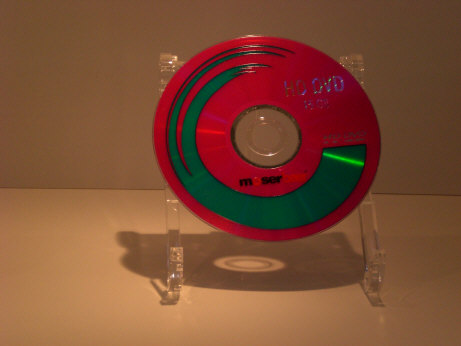
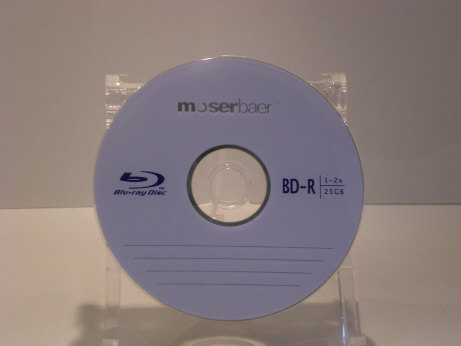
moserbaer had both single layer HD DVD-R and BD-R discs on display.
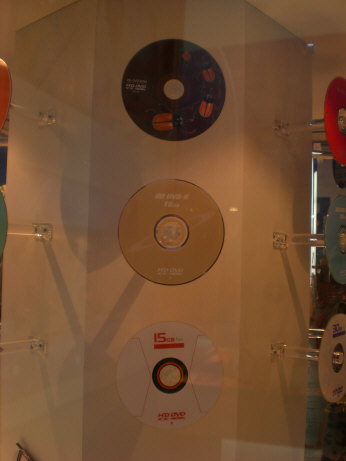
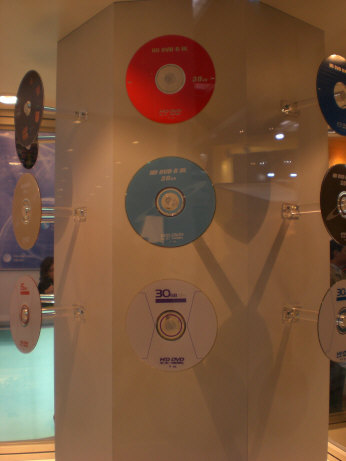
Unfortunately, I forgot to write down the company that makes these discs, but they sure had a lot of them on display. The same goes for Blu-ray blanks:

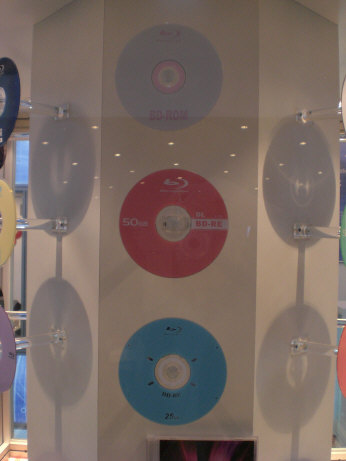
HD DVD and Blu-ray software players
Nero was showing off their upcoming HD DVD plugin for Nero Showtime at Toshiba's HD DVD booth. The plugin should be released any day now, and cost €25. Sadly, Nero joins Intervideo and Cyberlink in forcing playback restrictions upon the users that are not in the current AACS specs: specifically, no playback whatsoever if you're using a non HDCP capable digital link (including dual link connection).
[Update]: It appears I was mistaken on the HDCP bit. Despite all the press and DVD sites toting the partyline that there's no downscaling on onprotected outputs, this only applies to analog outputs. As far as digital is concerned, even the interim AACS specification mandates copy protection on digital outputs. So while you can still get 1080i via (lossy) analog, forget about getting anything, even ICT downscaled content via a link without copy protection. Now the non ICT enforcements suddenly appears in a whole different light, especially for PCs. VGA outputs get crappier and crappier if you up the resolution, so 1080p playback via analog is really no way to go. And if you go digital, you need HDCP. And since HDCP doesn't work over dual link displays, regardless of whether you have an HDCP capable GFX card and screen, it effectively comes down to either descrambling the content prior to playback or on the fly via AnyDVD HD, or being stuck with a black screen. Now tell me again how the industry is playing nice by not enforcing ICT and I'll hit you over the head with the box of my 30" Dell. Bottom line: if you have a display that goes beyond 1920x1080, you will not get any HD content playback via means the movie studios deem acceptable and the only way is to help yourself and get around AACS.
If you look at page 100 in the current AACS specs, it lists the authorized digital outpus and DVI without HDCP isn't on that list.
Cyberlink also had a booth and when asked about playback restrictions and downscaling, here's the answer I got:
If you have the Dell 3007FWP, you are screwed, period (the display can handle HDCP, but HDCP can't handle dual link DVI and thus the display's native resolution of 2560x1600). I was told that software player makers agreed to forbid playback over any non HDCP capable digital link - regardless of the specs and whether the ICT flag (the ICT flag can be set by studios to force downscaling to 960x540 over unprotected links - so analog links and no HDCP enabled digital links). For now, you could go analog and not be touched by any restrictions, but feeding a digital display via analog input makes little sense, especially at high resolutions where most GFX cards only provide significantly degraded output. So here you have it: unless your equipment offers HDCP, forget about using a digital link to play back high definition content - even though the 0.91 AACS specs contain no such restriction (to the best of my knowledge that is..).
ArcSoft was also showing their ArcSoft Digital Theatre 2 software - a combined Blu-ray and HD DVD playback solution. Unfortunately, I didn't stop by to ask about playback restrictions, but I'd be surprised if a US based company would be more forthcoming than Taiwanese software makers. Either way, the software has an advertised price of $69.99, was first introduced at CES, but is still not on ArcSoft's homepage so I doubt you can buy it at this point.
DVB
While DVB solutions were plentiful, I set out to look for something specific: PCIe (that's PCI Express) based cards. Compact PCs these days may already come without a PCI slot (my Shuttle SD37P2 does), and PCI is just lingering around and adding cost to every mainboard because not enough card makers dare to make a PCIe based card. Anyway, there is such a thing as a PCIe based DVB card and here is proof: a combined DVB-S2 / DVB-T PCIe based card from AVerMedia:
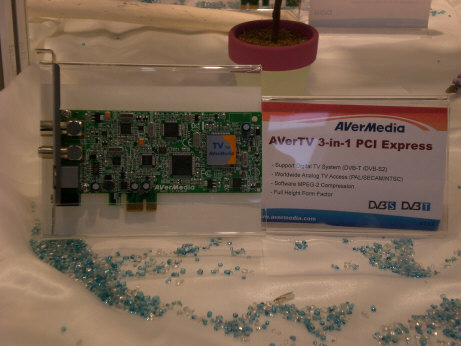
LifeView also has a combo DVB-S / DVB-T card (the PCIe 1 connector is well hidden but it is definitely there).
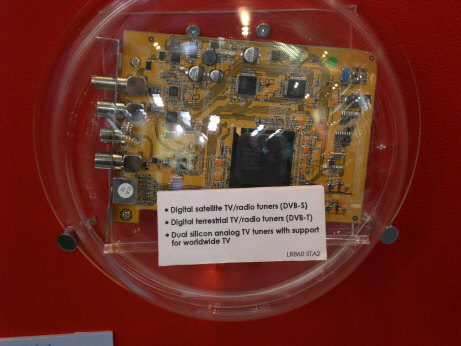
Kworld also makes a PCIe based DVB-T / Analog card, as does YUAN.
Once I established that PCIe solutions are out there, I went to the major players:
Terratec currently has a PCIe based DVB-T board but no plans for a DVB-S2 PCIe board.
Technotrend is considering PCIe for their next generation of budget cards, but those are 1-2 years off. In the meantime, they suggested their USB based DVB-S2 solution, and the upcoming USB based DVB-S2 box with CI support.
Technisat currently has no PCIe cards and no plans for releasing any - the same goes for Haupauge.
So there you have it - the little guys prove to be more innovative than the established players. Provided the card gets good 3rd party software support, the AVerMedia card will make my buying list shortly.
Final words
Seeing the press war going on between the HD DVD and the Blu-ray camp, I was a bit disappointed to not see a showdown on the floor. Also, I wasn't able to find anybody from Toshiba's product marketing to ask a few critical question about HD DVD's future. While Toshiba certainly seems confident HD DVD is here to stay and that they stand a good chance with the upcoming cheap standalone players - I had wished for a bit more aggressiveness in the face of Sony's constant PR barrage - or people will start buying the spin and think Blu-ray is at a place where it definitely isn't (once again, compare the sales numbers of DVD and the high def formats - the only conclusion at this point can be that we are very early in the market and that any victory cry is premature).